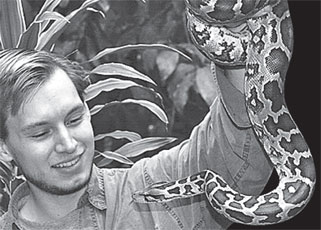Toxic - but life saving
 Most people find snakes, even the harmless ones, repulsive. Many
snakes have a fearsome reputation as venomous killers. Sri Lanka has a
large number of snake species, some of which are very dangerous. Sri
Lanka indeed has one of the highest rates of snakebite deaths in the
world, but hospitals routinely save hundreds of snake bite victims each
year through the timely application of anti-venom. (Worldwide, more than
100,000 people die of snake bites every year). Most people find snakes, even the harmless ones, repulsive. Many
snakes have a fearsome reputation as venomous killers. Sri Lanka has a
large number of snake species, some of which are very dangerous. Sri
Lanka indeed has one of the highest rates of snakebite deaths in the
world, but hospitals routinely save hundreds of snake bite victims each
year through the timely application of anti-venom. (Worldwide, more than
100,000 people die of snake bites every year).
Sri Lanka is known as a biodiversity hotspot and snakes are no
exception. The sheer variety of snakes found in the island has attracted
a number of foreign scientists to study the lives of snakes. Now, a new
study has found that the snakes in Sri Lanka are even more diverse than
previously thought.
Dr. Alex Pyron (Robert Griggs Assistant Professor of Biology at
George Washington University in the Columbian College of Arts and
Sciences) is among the foreign scientists who passionately study snakes
in Sri Lanka. In 2011, his fieldwork in Sri Lanka studying snake
diversity led him to confirm the identity of 60 known species of snakes
with the aid of the latest DNA sequencing technology and his Sri Lankan
collaborators, Ruchira Somaweera, an author on snakes and expert on
amphibians and reptiles, and Dushantha Kandambi, a local naturalist and
snake expert. Dr. Pyron’s work has been featured in the March edition of
the journal Molecular Phylogenetics and Evolution.
Apart from confirming Sri Lanka’s reputation as a biodiversity
hotspot, the study led to a greater understanding of how all the snakes
are related to each other and their evolutionary relationship with other
species globally. They found that Sri Lanka has been colonised by snakes
at least five times by totally different snake groups, which have each
diversified heavily within the island.
The study found several new species of snakes as well.
Oldest
It is worth quoting Dr. Pyron because we generally do not appreciate
the biological diversity of our island, perhaps because we see it every
day. “Sri Lanka has one of the oldest recorded civilisations on the
planet.
 |
|
Dr Alex Pyron with
snake |
Species are still being discovered there, and even the ones that were
known were not really ‘known,’ as the DNA data are telling us new
stories about how they are related, completely contradicting what we
thought we knew.
It tells us that Sri Lanka is a much bigger hotspot for biodiversity
than previously known, and harbours massive richness.”
Encouraging words, indeed from a respected scientist. We must in turn
protect this “massive richness” for posterity.
Every species, however repulsive or seemingly unnecessary, is
important in the circle of life. Once a species becomes extinct, it
cannot be brought back to life easily although scientists are working to
realise that goal too.
Sri Lanka has many endemic varieties of flora and fauna that must be
protected at all costs.
There have been many attempts at stealing the genetic fingerprints of
such species for research purposes abroad.
The authorities should find a proper mechanism to halt such illegal
activities.
The study outlined shows how local-foreign collaboration can ensure
the protection of local species through advanced research.
Most people in rural areas “know their snakes” so to speak, but
overall, there is little knowledge about snakes among the general
population. It pays to be able to identify snakes as venomous and
harmless ones - it could be a matter of life and death.
Snakes should not be confined to the biology lesson in school - a
lesson on snakes must be given to all schoolchildren at some point.
Electronic media too can step in to educate the public on snakes,
which are present even in densely populated urban areas. Sri Lanka could
also become a global centre for snake research.
Apart from studying their biological diversity, our zoological
facilities and universities can conduct research on snake venom, which
is fast becoming a hot area in biological research.
It may be surprising, but snake venom can be a potential lifesaver.
After all, snake venom is all about complex chemicals that affect a
victim’s body in numerous, often fatal, ways.
What if these same chemical compounds can be used to alleviate pain
and suffering and even heal a disease or a wound? That is the exciting
premise behind snake venom re-engineering.
For example, pain-relieving compounds - called mambalgins - isolated
from the venom of Africa's Black Mamba are as strong as some opiates,
including morphine, without the risk of respiratory distress and other
side effects common with pain-reducing drugs.
Scientific
The idea of using snake venom (and venom other creatures such as
spiders and scorpions) is not new - they have long been part of certain
Eastern medicine practices, but it is only now that scientific research
is being conducted in this field with a view to commercialisation of
such drugs.
Various compounds in king cobra, rattlesnake, and viper venom have
been found to have an effect on a wide range of maladies, ranging from
the dissolution blood clots to slowing the growth of cancer cells.
In fact, hundreds of toxins can be delivered in a single bite and
many of them could have medicinal properties.
However, we have not even touched the proverbial tip of the iceberg
when it comes to the (good) uses of venom.
Medicines for diabetes, hypertension and heart disease have already
been derived from venom and a better cancer medicine from venom could be
with us in a decade.
There is an even anti-ageing cream derived from the venom of the
temple of pit viper. However, more intensive research is needed at
global level in this sector with vast possibilities.
The possibilities are vast indeed; There are 100,000 animals that can
spew venom, including snakes; they produce 20 million estimated toxins;
Only 10,000 of them are known while only a measly 1,000 have been
studied in-depth.
It will take decades for scientists to analyse them all but there is
no doubt that even the most reviled creatures on Earth would help save
more lives with the very toxins that are usually intended for an exactly
different purpose.
|



